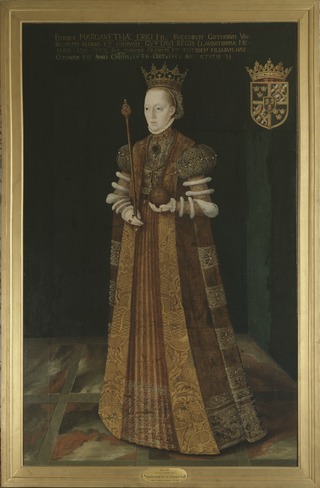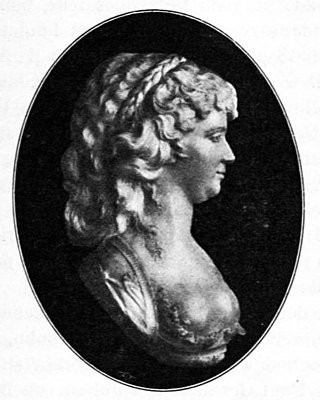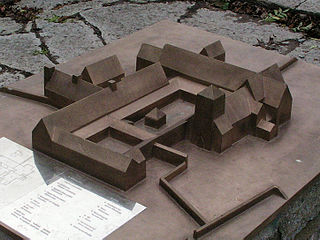Related Research Articles

Princess Margaret of Connaught was Crown Princess of Sweden as the first wife of the future King Gustaf VI Adolf. She was the elder daughter of Prince Arthur, Duke of Connaught, third son of Queen Victoria of the United Kingdom, and his wife Princess Louise Margaret of Prussia. Known in Sweden as Margareta, her marriage produced five children; she was the grandmother of King Carl XVI Gustaf of Sweden, Queen Margrethe II of Denmark and Queen Anne-Marie of Greece. She died 30 years before her husband's accession to the throne of Sweden.

Margaret Leijonhufvud was Queen of Sweden from 1536 to 1551 by marriage to King Gustav I. She played a political role as the advisor of, and the intermediary to, her spouse the King.

Christina Nilsdotter Gyllenstierna of Fogelvik was a Swedish noblewoman. She was married to the Swedish regent Sten Sture the Younger, and led the Swedish resistance against Christian II of Denmark after the death of her spouse. In her own lifetime she was simply referred to as Fru Kristina, but she has become known in history as Kristina Gyllenstierna because of the house of nobility to which she belonged.

The Ingrian War between the Swedish Empire and the Tsardom of Russia lasted between 1610 and 1617. It can be seen as part of Russia's Time of Troubles and is mainly remembered for the attempt to put a Swedish duke on the Russian throne. It ended with a large Swedish territorial gain in the Treaty of Stolbovo, which laid an important foundation to Sweden's Age of Greatness.

Laurentius Paulinus Gothus was a Swedish theologian, astronomer and Archbishop of Uppsala.

Erik Johansson Vasa was a Swedish noble and the Lord of Rydboholm Castle in Roslagen. His son would rule as King Gustav I of Sweden from 1523–1560.

Sofia Franziska Stading was a Swedish opera singer of German origin. She is referred to as one of the more notable opera singers in Sweden during the Gustavian era. She was a Hovsångare and member of the Royal Swedish Academy of Music from 1788.
Eva Margareta Frölich, was a Swedish mystic, prophet, visionary and Pietistic writer.

Vreta Abbey, in operation from the beginning of the 12th century to 1582, was the first nunnery in Sweden, initially Benedictine and later Cistercian, and one of the oldest in Scandinavia. It was located in the present-day municipality of Linköping in Östergötland.
A Swedish battalion during the mid 17th century up to the mid 18th century was the smallest tactical unit in combat. The 600 man unit was formed, temporarily, at the inception of a battle by joining four foot companies from a foot regiment of eight companies. The commander of the regiment, an Överste (Colonel), led the first battalion and his deputy, an Överstelöjtnant, the second battalion. Battalion commanders and all other officers marched in front of the formation. Non-commissioned officers (underofficers) marched beside and behind to prevent desertion, and to replace officers who were killed. In addition to his principal duties, senior officers, such as Majors, the Överstelöjtnant and Överste, also commanded a company. So that the Överste could focus on the operations of his regiment and first battalion, command of his company was delegated to a Kaptenlöjtnant. During battle, each officer, except the Fänriks, was in charge of a portion of his company. Underofficer (NCO) ranks comprised Furir, Förare, Fältväbel, Sergeant and Rustmästare.
A Swedish foot (infantry) regiment during the 17th and 18th century was split into two battalions at the inception of a battle and light field artillery was usually put in the gaps that appeared between those battalions. This sort of artillery was categorized as regimental artillery.

Colonel Samuel Cockburn was a Scottish soldier in the service of Sweden who sometimes took the role of (generalfältvaktmästare) a temporary role akin to a major general, but not a fixed rank. He was born around 1574 in Scotland. He entered Swedish service in 1598 where he participated in the Swedish civil war between Sigismund Vasa and his uncle Duke Karl, later Karl IX.
Anna Sofia Ramström (1738–1786) was a kammarfru of the Queen of Sweden, Sophie Magdalena of Denmark. She was known for her involvement in the famous affair of the consummation of the marriage between the royal couple.

Margareta Slots or Margareta Cabiljau was the royal mistress of king Gustav II Adolf of Sweden and the mother of his illegitimate son Gustav of Vasaborg.
Sara Simonsdotter, called Tjocka Sara, was a Swedish brothel owner and procurer in 17th-century Stockholm. Her brothel had clientele among the royal court and became the centre of a scandal when it was revealed in 1618.

The Skogsrå, Skogsfrun, Skogssnuvan, Skogsnymfen, Råndan or Huldran, is a mythical female creature of the forest in Swedish folklore.

Events from the year 1628 in Sweden
Events from the year 1626 in Sweden
The Storming of Kristianopel occurred on 26 June 1611, during the Kalmar War. Gustavus Adolphus of Sweden led an assault from the camp in Högsby in Småland on Kristianopel in Blekinge. The Swedes managed to siege the fortified city and went in by bombing the fortress port, which was badly defended. Right after the assault, there was a massacre of the city's population, with rape and pillaging.

Margareta Nilsdotter also called Margareta Hybertsson was a Swedish businessperson and shipbuilder. In 1627, she completed construction of the Swedish warship Vasa.
References
- ↑ Göte Göransson: Gustav II Adolf och hans folk (Gustav II Adolf and his people) Stockholm (1994) ISBN 91-7119-128-3.
- ↑ Göte Göransson: Gustav II Adolf och hans folk (Gustav II Adolf and his people) Stockholm (1994) ISBN 91-7119-128-3.
- ↑ Göte Göransson: Gustav II Adolf och hans folk (Gustav II Adolf and his people) Stockholm (1994) ISBN 91-7119-128-3.
- ↑ Göte Göransson: Gustav II Adolf och hans folk (Gustav II Adolf and his people) Stockholm (1994) ISBN 91-7119-128-3.
- ↑ Göte Göransson: Gustav II Adolf och hans folk (Gustav II Adolf and his people) Stockholm (1994) ISBN 91-7119-128-3.
- ↑ Göte Göransson: Gustav II Adolf och hans folk (Gustav II Adolf and his people) Stockholm (1994) ISBN 91-7119-128-3.
- (in Swedish) Göte Göransson: Gustav II Adolf och hans folk [Gustav II Adolf and his people] Stockholm (1994) ISBN 91-7119-128-3.
- (in Swedish) Jan Wall : Den ogudaktige prästen och de predikande kvinnorna. Om folkligt reformationsmotstånd under Vasatiden. [The ungodly vicar and the preaching women. Opposition to the reformation during the Vasa era] RIG - Kulturhistorisk tidskrift, vol. 77, nr. 1, 1994
- Klaës Alfred Hagström : Strengnäs stifts herdaminne, Fjärde delen, 1901